Abstract
The chief trend of Information Age is visualization of information blocks which provides timely control of information, its usage in scientific research, and in supervising complex objects, economy, etc. The main function of visualization is to provide information in the form which is visually and logically convenient for the user. With this purpose it is changed and improved on cognitive principles of presenting knowledge: structures are created, elements are connected and curtailed at marking elements and relationships. In other words it is compressed for better understanding the knowledge and using it. Visualization occupies a deserving place in education. It improves the quality of professional, scientific and training activities. The research is held both in our country and abroad, where due to works, such as “mental maps”, “maps of the mind” and “concept maps” a high level of visual literacy in education and production activity is provided. Remarkably, that a corresponding organizing-information resource is founded: Journal of Visual literacy, International Visual Literacy Association, Artstor Digital Library. Various trends of visualization are worked out within the above mentioned trends; one of them is logical cognitive modeling of knowledge, presented on a natural language. The peculiarity of approach is search of nature comfortable (socio-cultural) basis of graphic coordinating basic foundation for logical-cognitive models which provide their image-notion character. The article deals with peculiarities of structure and didactic functions of logical-cognitive models and their usage in didactic design.
Keywords: Informationeducation spacevisualizationlogical-cognitive modellingmodelsdidactics
Introduction
One of the chief trends of the information age is visualization of information blocks, which provide quick control, implementation of taken decisions in managing complicated objects, in running economy, etc. Information based panels of management in technology and science prove it, as well as various infographics in the Internet , “paper” technology of visualization in education and various spheres of production. The peculiarity of the trend of visualizing information is its presentation in visual and logically convenient form of usage. For this purpose it undergoes changes on the basis of three principles of cognitive presentation of knowledge: it is structured, bind element after element and folded when elements are marked. Such presentation of information enables students’ better understanding, comprehending and use of the information.
Visualization has taken a decent place in the education space; its quality approaches the quality of visualization of information in professional, scientific and productive activity. Active and multi-directed research in this sphere is widely held abroad: resources of memory are studies, as well as their actualization with the help of visual images, the role of visualization in the process of tuition and cognition is studied, concrete visual means of info graphics, maps of memory, mental maps are worked out, etc. Among numerous foreign works special attention is drawn to multiple research of forming visual literacy, and, consequently, visual competence in different spheres of activity. The approach in question is rational; it provides a considerable total effect.
The founders of the direction “mental maps”, “maps of the mind” and “concept maps” Buzan, (1974, 2003); (Shteinberg, Davletov, Vakhidova), Novak, (Kinchin, 2015) and their numerous disciples (Brill, Kim, Branch (Shteinberg, Davletov, Vakhidova) – investigations of visual literacy; Clark (Artstor Digital Library, 2016) – visual tools and methods for reflecting concepts; Johnson (Clark, 2011) – corporal foundation of meaning and imagination; Kinchin (Sowa, 1984) – management of knowledge and electronic tuition; Kouyumdjian (Johnson, 1987) – tuition with the help of visual effects; Lindelani Mnguni (Busan, 2004 – theoretical cognitive process of visualization of natural scientific education: perspectives and literature; Villalon, & Calvo (Mnguni, 2014) – concept maps as cognitive visualization of written tasks; Wilgis, & McConnel (Novak, 1998) – strategies in the field of education for improving skills of critical mentality of nurses) provided in their countries a high level of visual literacy in education and various spheres of productive activity. It is noteworthy that the results of research on the problem of visual literacy are supported by a complex of organizing information resources, including Journal of Visual Literacy (International Visual Literacy Association: IVLA, 2016), International Visual Literacy Association (Brill, Kim, Branch, 2016), Arstor Digital Library (Shteinberg, 2015). Figure
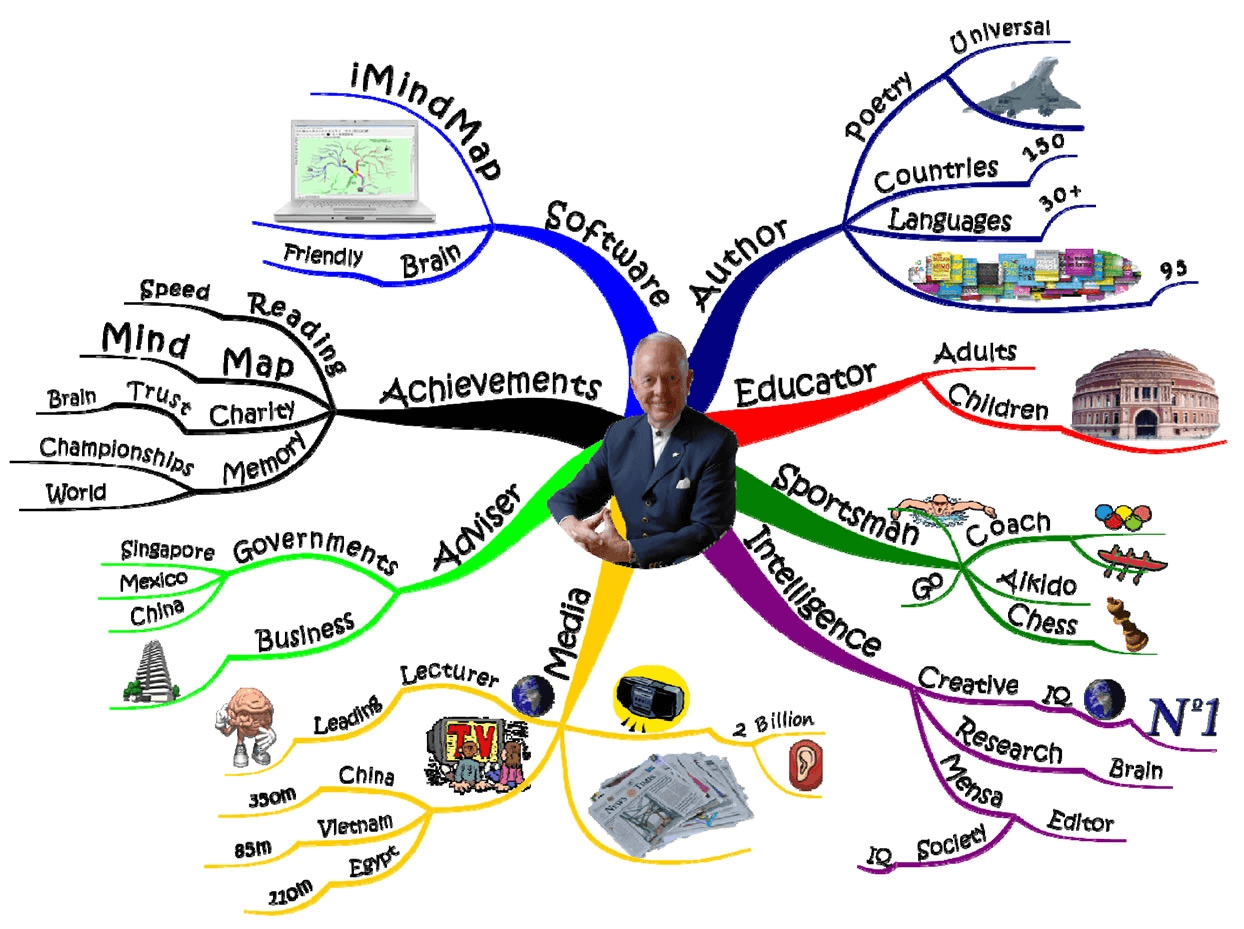
It is worth acknowledging that working out problems of graphical, visual and other types of literacy is very urgent in Russia for the native system of general and professional education. Psychologists state that within recent period schoolchildren changed their apprehension of information: it became fragmental, “clip-like”. Consequently, teachers are recommended to actively use mixed tuition, using informational means of tuition, as well as methods and technologies, based on visual images of the material of illustrative type. This approach is justified for primary schoolchildren, but senior schoolchildren require the material which is brought into system and can be studied more profoundly. It is necessary, in particular, to teach pupils to analyze in order to learn the material more profoundly, to teach them to form and develop their ability of working out algorithms and plans of solving the educational tasks and the given problem, to control and estimate the expected results. In other words, it is necessary to teach pupils to learn, that is the chief result of studying at school should become formation of subject and universal actions, which provide the possibility to continue education; formation of skills – the ability of self-organization in solving educational tasks; individual progress in basic spheres of personal development – cognitive, emotional and self-regulating.
The defined problem should be solved by combining visual optical images of the learning material with universal training material of different complexity: from frequently fulfilled one step up to multistep scenario type, according to Federal State Educational Standards (FSES). It is necessary to have universal technology of reflection in convenient visual and logical form of the training material, training actions with it, as well as rules of shaping the learning outcomes. It should be mentioned that in this research we do not consider numerous empirical structure logical schemes, various basic signals, info graphic structure sand the like, for they do not possess modeling and image notion qualities.
The founder of visual logical cognitive modeling of knowledge, given in a natural language (the language of tutoring), is Subbotin (1980). The idea of this method is in formalized analysis of documental information streams: for each utterance expressed by a separate word, word combination or a sentence, all its logical ties with other utterances in the given subject sphere are singled out, forming a non-oriented graph, which is analyzed as a logical semantic model in the sphere in question. Such models approach hyper-texts, enabling us to observe the development of the subject sphere. Russian scholars Tkhachenko, Shteinberg, Manko work out the graphic realization of logical semantic modeling method. (Manko, 2007, 2009), (Manko, 2011), (Tkachenko, Shteinberg & Manko, 2015, 2016), (1993-2017). The distinctive feature of this method is the search nature conforming socio-cultural foundation for such a graphic basis of logical semantic models, which gives them image notion character. The developing models are meant for being used in didactic design for various academic subjects (The theme of the article is due to the use of information-packed eight illustrations.) .
Research Questions
The phenomenon of logical semantic modeling which is being adapted to the needs of didactics consists in: singling out the basic elements of the content in information or teaching material, finding relations between singled out elements, in binding those elements and relations for compressing information at its visualization. It should be noted that the above mentioned principles of cognitive presentation of knowledge are realized to this or that extent in info graphics, semantic nets, graphs, frames, structural logical schemes.
The research question, according to the authors, has a multi-measured character, which conditions its vagueness and originality. While solving it, that is, searching graphic foundation of the logical semantic modeling, the following heterogeneous tasks should be carried out:
attaching to the models image-notion character, preserving the cognitive principles of presenting knowledge, necessary for wholesome visual perception;
their universal character, which enables their usage on different levels of education and in various spheres of activity;
appointed formalization – for being used in engineering graphics and computer technologies;
registration of social, cultural and bio-social experience of a man in material space, for transition of this experience into the sphere of abstract knowledge space;
multi-functional models, which are necessary for constructing, on their bases, didactic regulators of educating process;
lack of complete definition, not final reflection of knowledge, that is presentation of “knowledge constructor” , which should provoke to the operating with knowledge, its analysis and synthesis (this requirement means reduction of dominance of illustrative function and strengthening the regulating and directing function).
Purpose of the Study
In view of the above enumerated complex of requirements to the graphic realization of logical semantic modeling, the purpose of the research can be defined as the search of the form of visualization of knowledge, which rests on social cultural foundation and is included into educational cognitive activity. That is, it is not only a “key” to intellect (
Research Methods
As it follows from the purpose of the study and considering multi-sidedness of the problem in question, the following specific methods of research were used:
study of the essence of the notion multi-sidedness in various spheres of activity and finding its adequate visual equivalent, which can be used for building logical semantic models (further LSM);
study of invariant graphic elements in artifacts of social cultural and bio-social experience of human orientation in material space, necessary for graphic realization of logical semantic modeling;
search of projecting and experimental research of qualities and effectiveness of various didactic regulators of education process on the basis of visual logical semantic models.
Findings
Research – graphical form of visualization of logical semantic modelling of knowledge, presented on a native tongue, – was carried out at several stages.
At the first stage we studied the essence of the phenomenon “multidimensionality” in various spheres of activity and its adequate visual equivalent was singled out, on which it was possible to build LSM. Multidimensional structures of scientific images were studied, as well as multi-measured objects of the educational system (the contents of education – three lines of logics: working out and learning knowledge and experience, age and educational evolution of the human being), technology of tuition (sensory, verbal logical and model “mould” of the studied object), levels of information processing (empirical and theoretical), means of studying the world (cognition, experience and estimation). Special attention was paid to the three formulated forms of human mentality: first the image of this or that phenomenon, then its analysis and synthesis of knowledge, and, in conclusion, working out models of the object or phenomenon in question. All this enabled the authors to suggest a hypothesis about three presentations of knowledge and three mechanisms of human mentality which operate with them (Figure
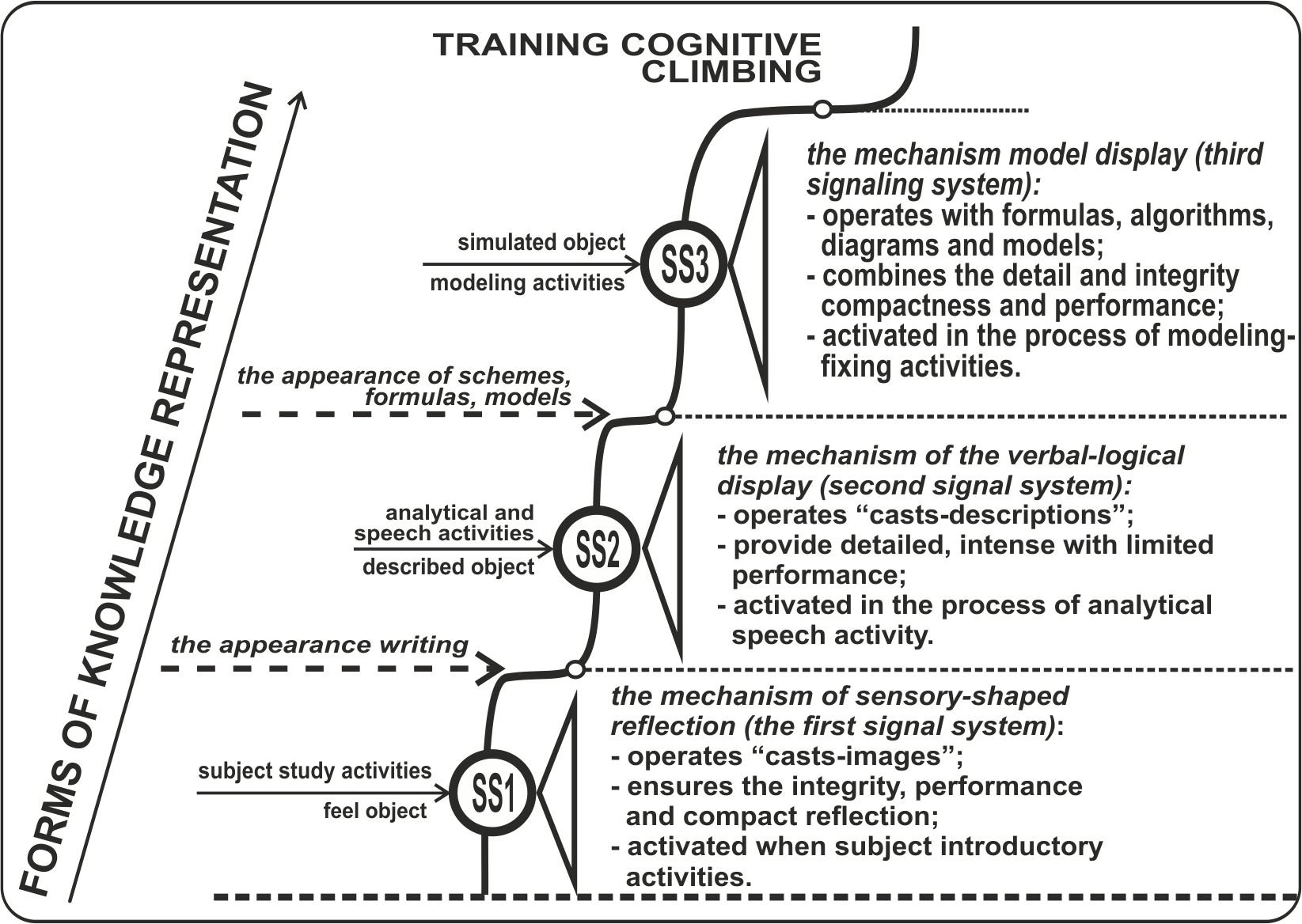
Coherent creation and mastering of the three basic notions of knowledge by the humanity – namely: material, verbal and modeled supported the idea of adapting the method of logical semantic modeling of knowledge and its application in didactics. Visualization of the phenomenon “multidimensionality” is suggested in the form of “strength lines” of mentality, which define the logics of organizing knowledge. The authors also suggest didactic category of “multidimensionality” as well as its graphic equivalent – various conditional coordinates of the existence of the objects and their qualities (Shteinberg, 2002).
Invariant graphical elements in artifacts of social cultural experience were studied on the second stage, namely, the applied graphics of world famous signs and symbols (symbols of this type possess the important meanings, events, certain social experience is fixed in them); solar ray structure of organic and non-organic thing; radial-circular architecture of cupolas of temples and mosques; and also bio-social experience of human orientation in material space (north-south/ forward-backwards, east-west/ right-left) (Figure
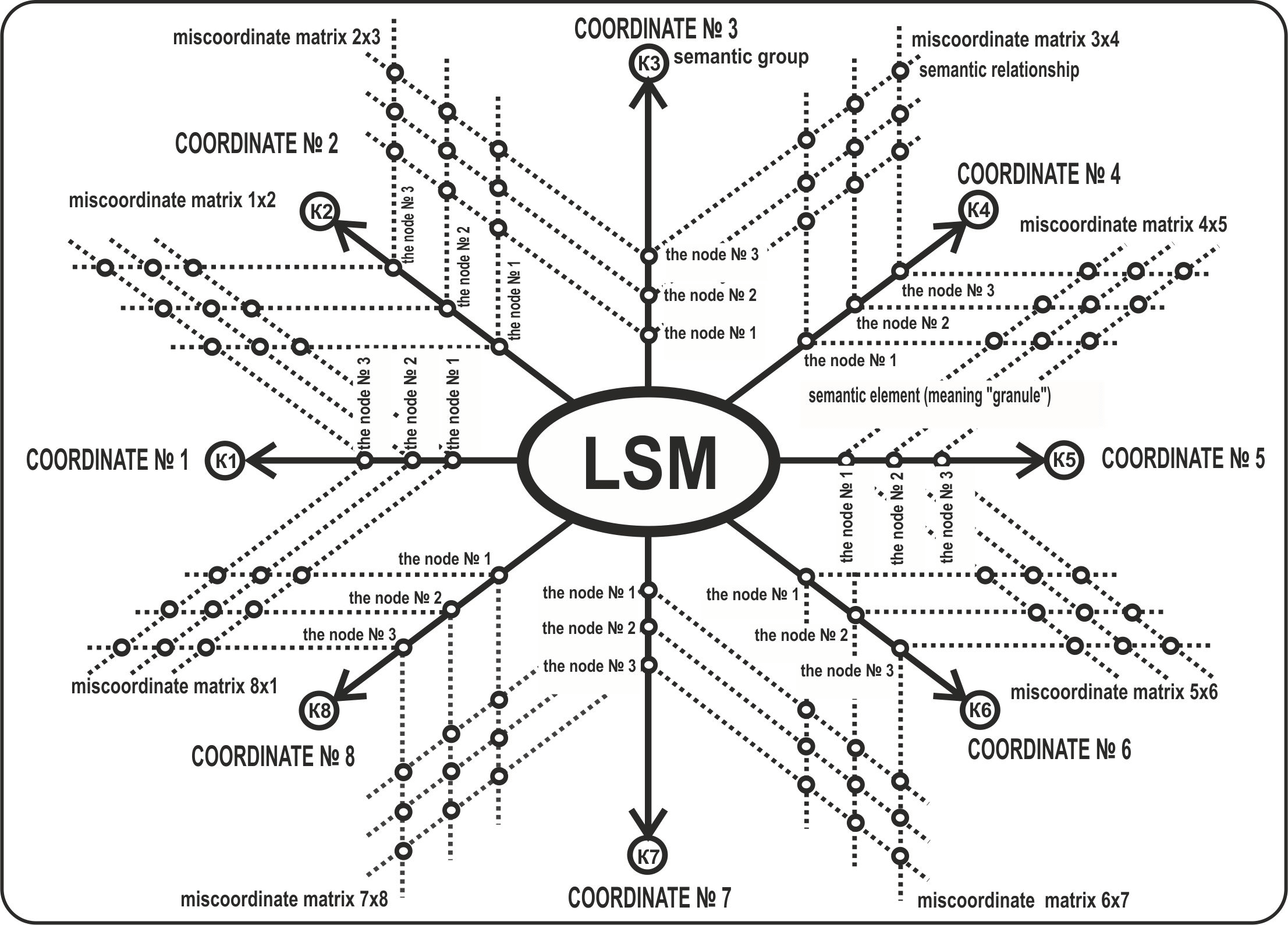
The results of the research show the radial-circular elements of graphical realization of logical semantic modeling and enable to suggest multidimensional coordinating matrix structure of the “framework” of LSM (Figure
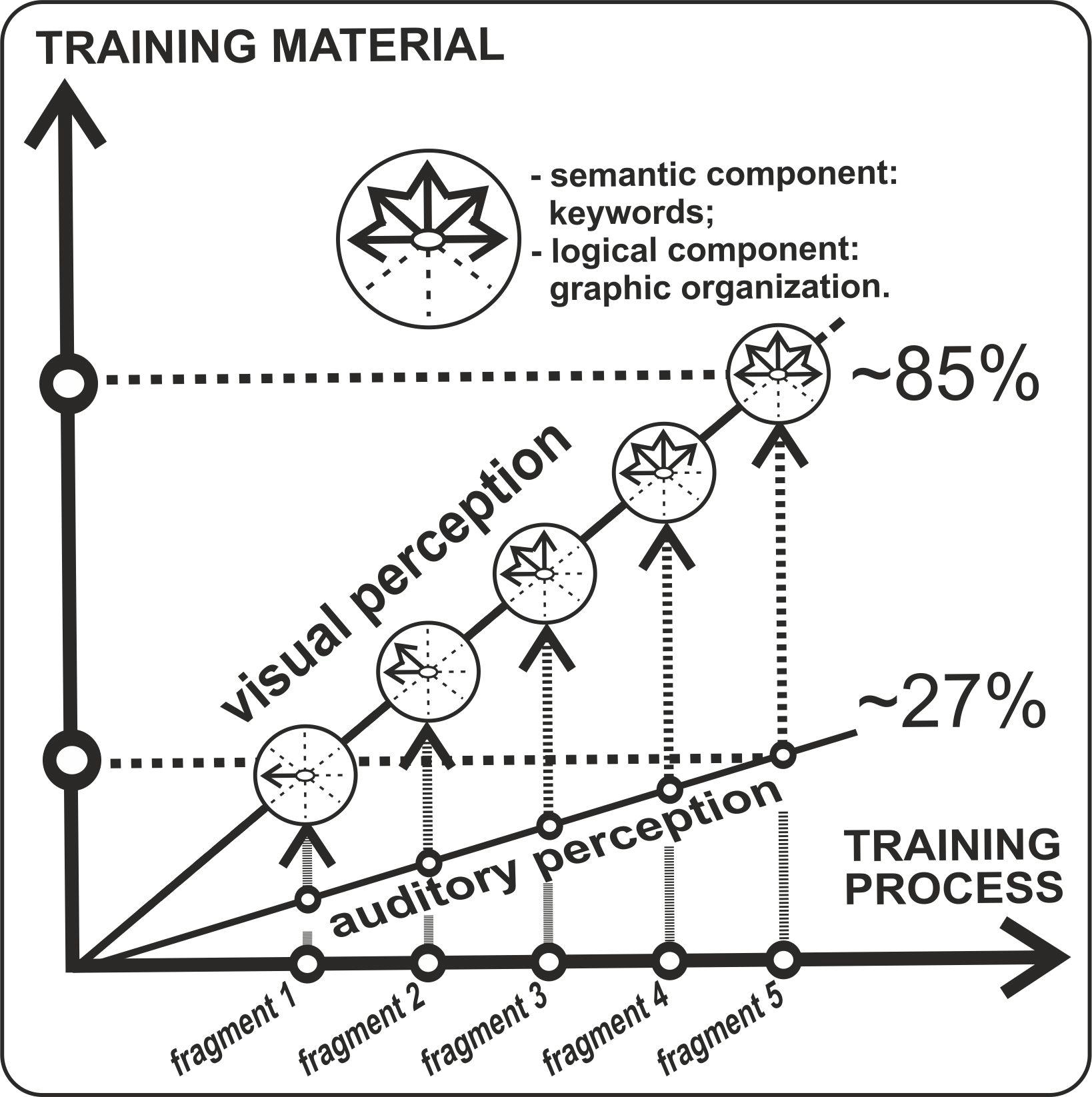
On the third stage realization of the search design was realized as well as experimental research of the properties and effectiveness of various didactic regulators of the education process, which are constructed on the basis of visual LSM. The place and role of LSM in the process of transition and comprehension of the education material is stated (Figure
Inclusion of LSM into the education process realizes parallel presentation of the education material in verbal, audio and textual forms, and in the visual form – in the logically convenient form. This enables to renew in the process of training activity the role of the first signal system – informationally more mighty and historically earlier, provides coordination of this work with the work of the second, more complicated signal system, which is analytically more delicate, at understanding, comprehending, improvement, fixation and reproduction of the training material.
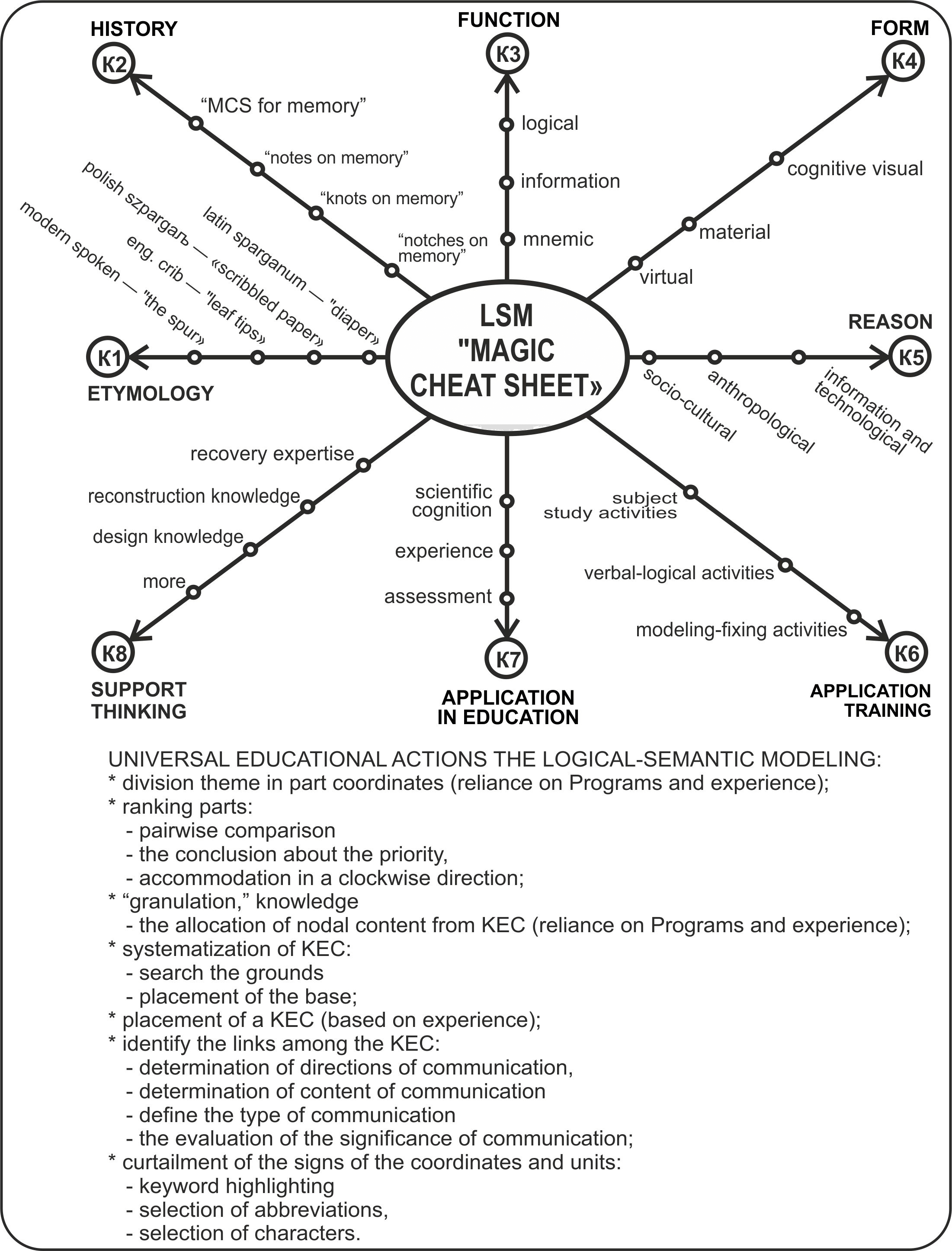
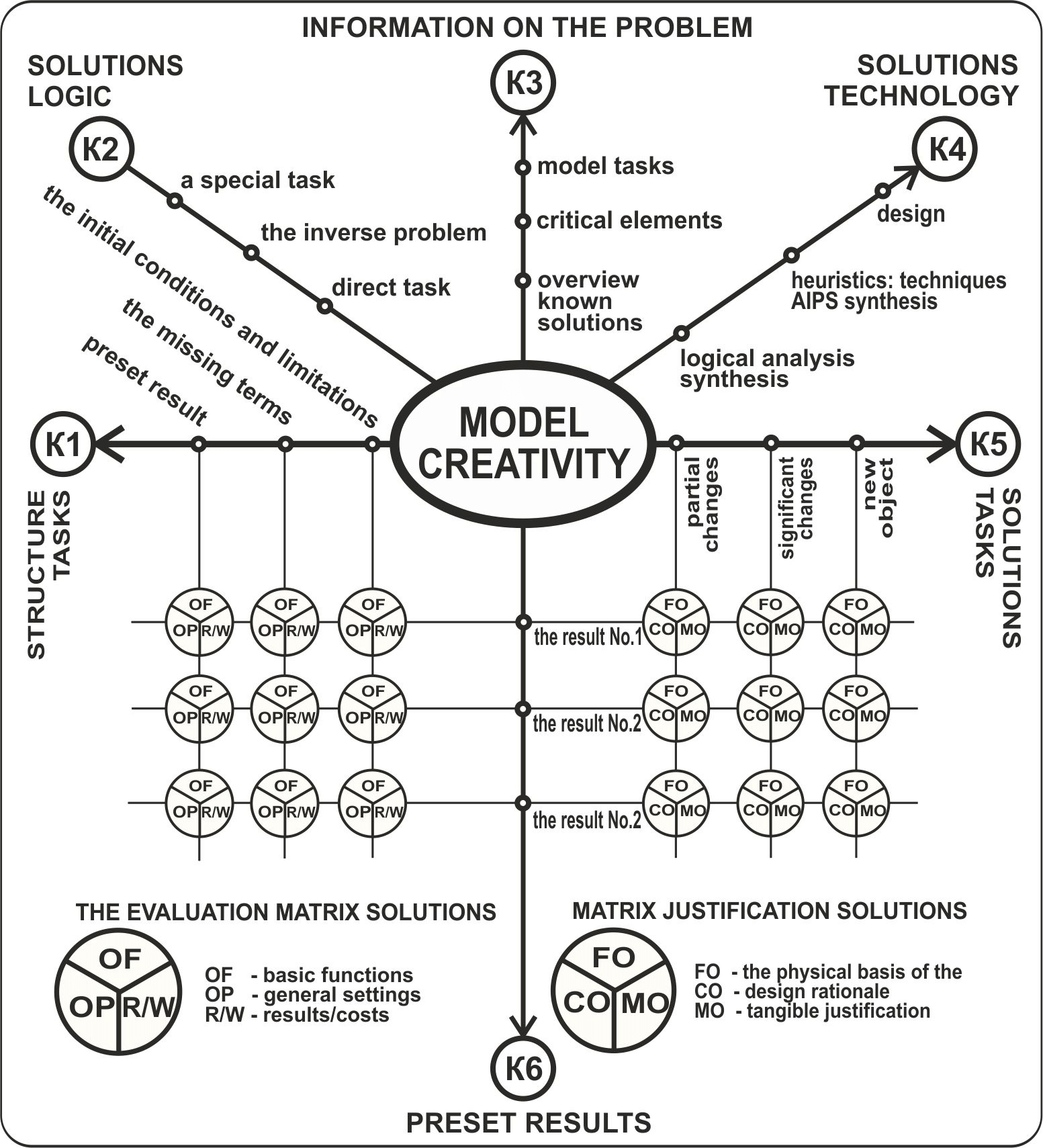
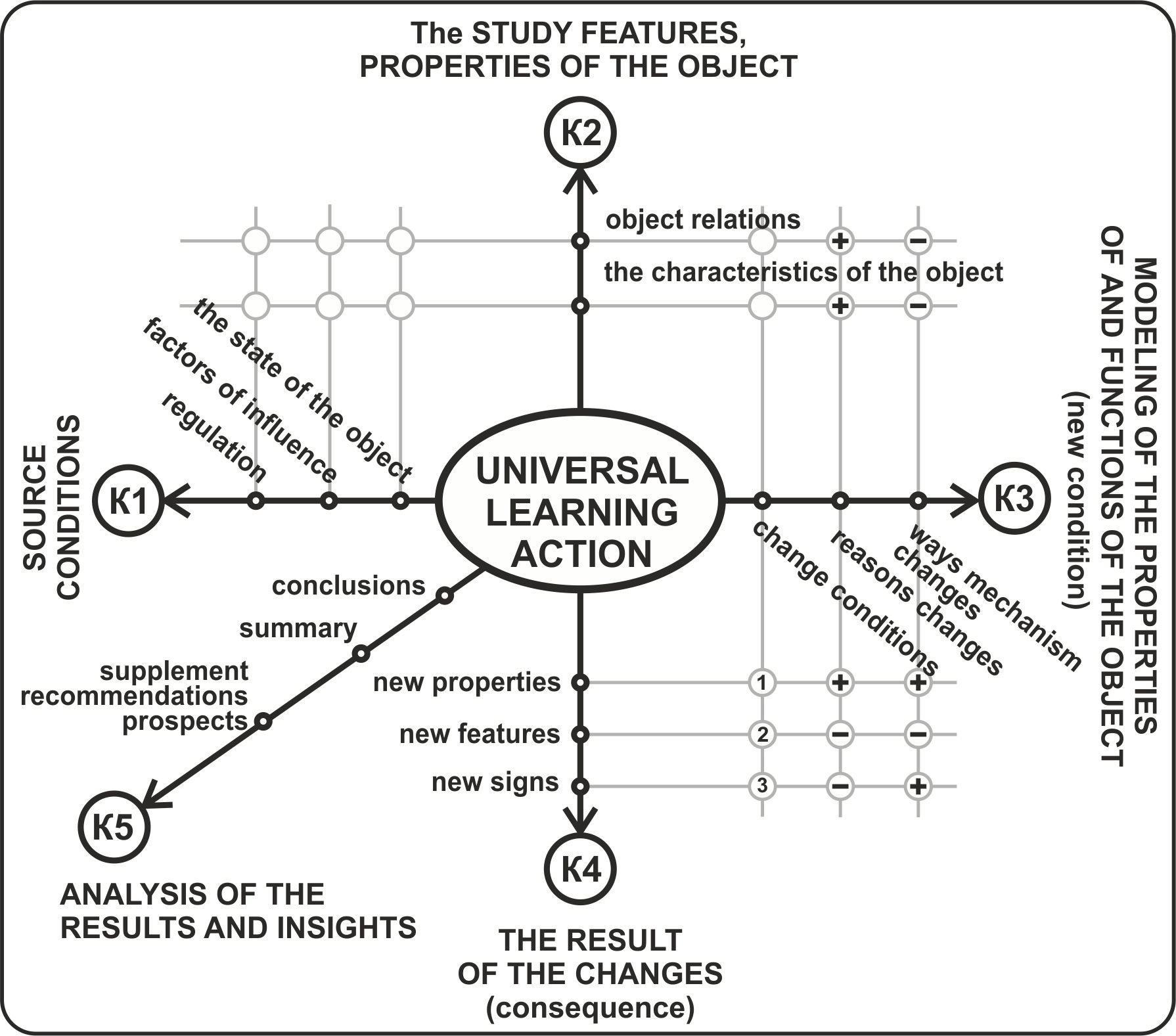
Within the period of 1993-2017 experimental work was being held in clearing out the functions, inherent in LSM within the frame of didactic design, five basic functions were worked out which are presented in pictures 8 (Tkachenko, Shteinberg & Manko, 2015, 2016). Experimental work was held “vertically” in all fields of education: in kindergartens, secondary schools, colleges, higher educational institutions and the system of additional education. Logical semantic modeling was successfully used in scientific, including dissertation research, and in creative work of teachers. The information about it is presented on the site of scientific laboratory of didactic design (Scientific laboratory, 2017) and the section of didactic design of the Academy of professional education (Section of didactic design, 2017).
Discussion
The results of the research enable us to think visualization of logical semantic modeling of knowledge, presented in native tongue, to be an effective direction of the general trend of the visualization of information. We consider the resource of visualization of logical semantic modeling of knowledge and corresponding models as important and perspective. Didactic means, which we have worked out (LSM) are the sort of “medicine” for treating defects of the traditional methods of teaching, which suffer from the “tyranny of verbalization”, which also promotes learning the project method. The given visual constructions are multi-functional and perform the functions of presenting knowledge and activity, tools of the study of educational objects, tools of projecting of elements of educational processes, macro- and micro-navigators in electronic textbooks (Shteinberg, Davletov, Vakhidova; Kouyoumdjian, 2012; Journal of Visual Literacy, Brill, Kim, Branch, 2000; Stokes, 2002). When LSM is built important educational actions are learned, which form the foundation of the learning technique.
Thanks to the graphic realization of logical semantic method of modeling the research of the psycho-pedagogical foundation of cognitive visualization of pedagogical objects, phenomena and processes are carried out, as well as the fundamental category of pedagogic “didactic image” (Manko, 2009, 2011). Didactic image, as a category of pedagogic, has a dual character, which, on the one hand, represents the world generally in images of knowledge about the object studied, and, on the other hand, general presentation of the image of the educational cognitive actions, or a number of actions with objects, for a human being interacts actively with the surrounding world. Didactic image, as a system created artificially is a cognitive means of acquiring new knowledge about the learning objects and means of interaction with them. It is also a means of orientation (oriental basis of activity) and navigation of the researcher in space, and regulative, which rules the mechanism of rhythmic arrangement of actions, operation of cognition of subjects.
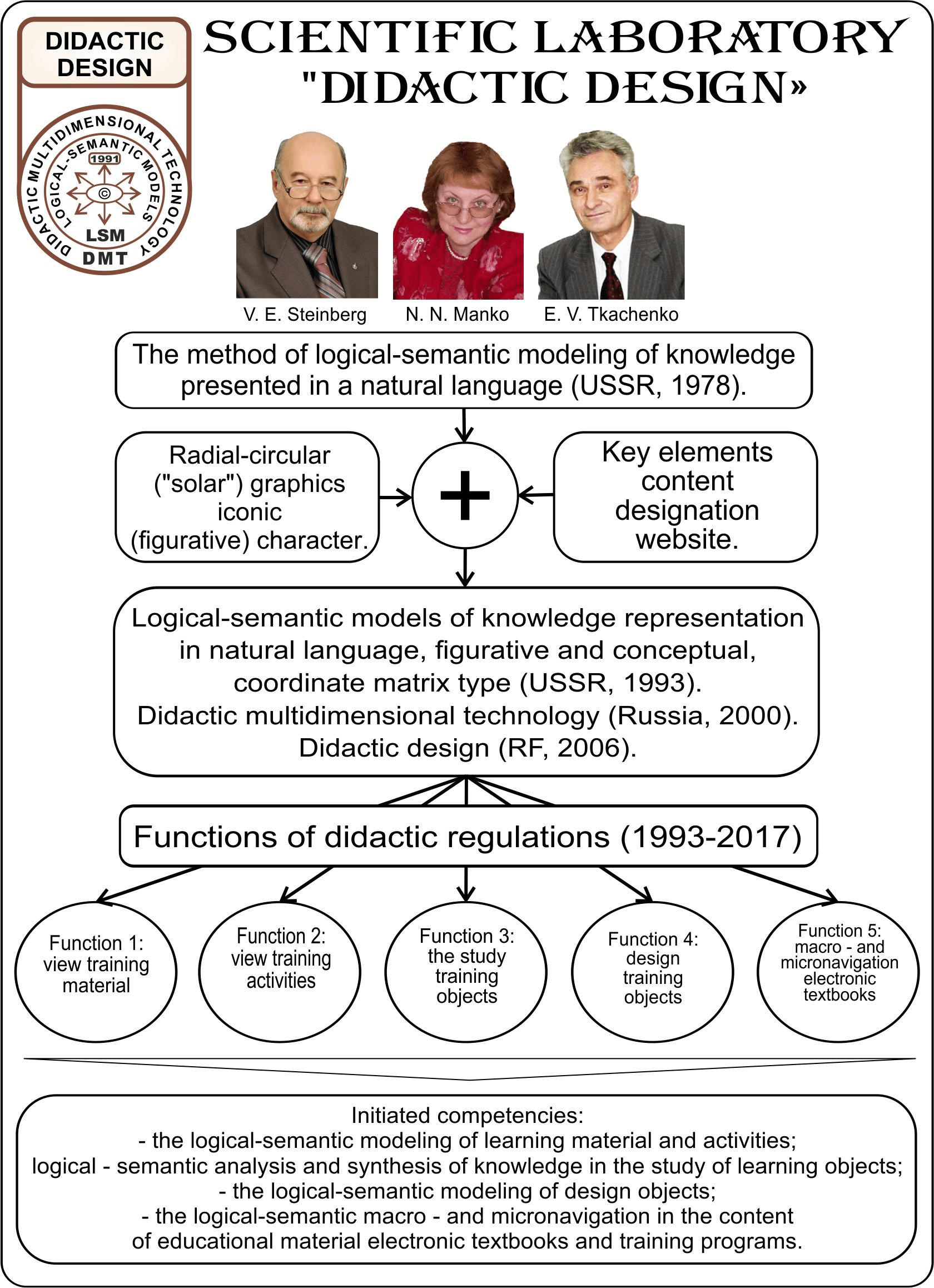
Embedding LSMs that have figurative and conceptual properties in the educational process allows to actualize the resources of the visual channel of information perception, and also to increase the efficiency of external and internal plans of educational cognitive activity, to initiate the learner's internal dialogue due to LSM.
Foundation of logical semantic modeling of knowledge, presented in native tongue, gives ground for evolutionary development of the project approach to the scheme “planning – projecting - design” (Tkachenko, Shteinberg, Manko, 2015), (Stokes, 2002, Villalon & Calvo, 2011, Wilgis & McConnell, 2008). Research in this field is held together with the scientific laboratory of didactic design of the Institute for Strategy of Education Development and Bashkir State Pedagogical University after Akhmulla, Didactic design section of the Academy of professional education (Section of didactic design of the Academy of Professional Education 2017); Internet monitoring of using LSM by teachers (Scientific laboratory, 2017).
Conclusion
The purpose, stated in the work – the graphic form of realization of logical semantic modeling of knowledge, presented in a natural language is achieved:
coordinating matrix schemes of logical semantic models provide visual and logical convenience for perception and operation;
logical semantic models are universal and can be used in the matrix of education in coordinating “ levels of education” and “education subjects”;
logical semantic models are multi-functional and can be used, depending on the information, reflected by them, as basic schemes, orienting basis of actions, navigators in the contents of education material and in hypertextual technologies;
it is important, due to the weakening of subject-subjective interaction in education as a result of formal inanimate innovations (standards, testing methods of tuition and control, universal state examination etc.), logical semantic models can, for account of their creative character, activate the interaction between the learner and the teacher in the education process, and thus compensate some losses, which are inevitable in formal approach to its realization;
on the basis of logical semantic models perspective direction in didactics is formed – instrumental didactics and didactic instrumental design.
So, we can state, that visual knowledge is a global and progressive tendency of modern information age, embracing science, technology, education, as well as visualization of knowledge, presented in the native language (the language of tuition) with the help of logical semantic modeling, represents an important part of the existing tendency in the space of modern education.
References
- Artstor Digital Library (Date of access 9/15/2016) (from URL: http://www.artstor.org) [in Russian]
- Brill J.M., Kim D., Branch R.M. (2000) Visual literacy defined: the results of a Delphi study: can IVLA (operationally) define visual literacy?. [Paper presented at the International Visual Literacy Association, Ames, IA]
- Buzan T. (1974). Use Your Head. London: BBC Books, 157 p.
- Busan T. (2003) Super thinking. Minsk, Open Company "Popuri". ISBN 985-438-994-4. [in Russian]
- Busan T. (2004) Teach yourself to think! Minsk, Open Company " Popuri ". ISBN 985-438-856-5. [in Russian]
- Clark C. (2011). Best tools and practices for concept mapping. University of Notre Dame. Retrieved from (Date of access 9/15/2016) (URL: https://ltlatnd.wordpress.com/2011/05/10/best-tools-and-practices-for-concept-mapping/)
- International Visual Literacy Association: IVLA (Date of access 9/15/2016) (from URL: https://www.google.ru/search?hl=ru&q=International+Visual+Literacy+-Association+)
- John F. Sowa (1984), Conceptual Structures: Information Processing in Mind and Machine, Addison-Wesley, Reading, MA.
- Johnson Mark. (1987) The body in the mind: The bodily basis of meaning, imagination, and reason. Chicago: University of Chicago Press, 1987. 29p.
- Journal of Visual Literacy (Official Journal of IVLA).Retrieved from (Date of access 9/15/2016) (URL: https://www.ohio.edu/visualliteracy).
- Kinchin I. (2015). Novakian concept mapping in university and professional education. Knowledge Management & E-Learning, 7(1), 1-5.
- Kouyoumdjian H. (2012). Learning through visuals. Visual imagery in the classroom. Psychology Today. Retrieved July 5, 2014 (Date of access 9/15/2016) (from URL: http://www.psychologytoday.com/blog/get-psyched/201207/learning-through-visuals).
- Lindelani E Mnguni. The theoretical cognitive process of visualization for science education 2014. Retrieved from (Date of access 9/15/2016) (URL: http://www.springerplus.com/content/3/1/184).
- Manko N.N. (2007) Cognitive visualization of didactic objects: Monograph. Ufa: Publishing house of BSPU, 180 p. ISSN 5-87978-364-2. [in Russian]
- Manko N.N. (2009) Cognitive visualization of pedagogical objects in modern learning technologies. Education and Science: Izvestiya Ural Branch of RAO. 2009. № 8 (65). P. 10-31. ISSN 1994-85-81. [in Russian]
- Manko N.N. (2011) "Didactic image" - a fundamental category of pedagogy. Professional pedagogy: categories, concepts, definition. Ekaterinburg. Issue. 6. P. 135-143. ISBN 978-5-4430-0004-6. [in Russian]
- Novak J.D. (1998). Learning, creating, and using knowledge: Concept maps as facilitative tools in schools and corporations. Mahwah, NJ: Lawrence Erlbaum Associates.
- Scientific laboratory of didactic design of BSPU named after. M. Akmulla. Retrieved from: http://gym1.oprb.ru/template/guest/partner/index.php?id=6) (date of access 15.03.2017 ). [in Russian]
- Section of didactic design of the Academy of Professional Education. Retrieved from: http://apo-profobr.ru/page-65.html) (date of access: 15.03.2017). [in Russian]
- Shteinberg V.E. (2002) Didactic multidimensional tools: theory, methodology, practice (monograph). Moscow: Public Education, 304 p. ISBN 5-87953-160-0 [in Russian]
- Shteinberg V.E. (2015) Theory and practice of didactic multidimensional technology (monograph). Moscow, Public Education, 351 p. ISBN 978-5-87953-366-8. [in Russian]
- Shteinberg V.E., Davletov OB, Vakhidova L.V. , Etc. Certificate of state registration of the computer program №2016614812 "Electronic educational resource" Training program-tutor "DMT_DESIGM (SA) .1"". [in Russian]
- Shteinberg V.E., Davletov OB, Vakhidova L.V. Etc. Certificate of state registration of the computer program № 2016662458 Electronic training program "DMT-Autotyutor". [in Russian]
- Stokes S. (2002) Visual literacy in teaching and learning: a literature perspective. Electronic Journal for the integration of Technology in Education. 1(1): P. 10–19.
- Subbotin M.M. (1980) On the logical and semantic modeling of the contents of managerial decisions. Scientific management of society. Issue. 13. [in Russian]
- Tkachenko EV, Shteinberg V.E., Manko N.N. (2015) Didactic design - instrumental approach. Pedagogical Journal of Bashkortostan № 6 (61), pp. 74-87. [in Russian]
- Tkachenko EV, Shteinberg V.E., Manko N.N. (2016) Didactic Design - Instrumental Approach (continuation). Pedagogical Journal of Bashkortostan No. 1 (62), P. 50-65. [in Russian]
- Villalon J. & Calvo R. A. (2011). Concept maps as cognitive visualizations of writing assignment. Educational Technology & Society, 14(3), 16-27.
- Wilgis M. & McConnell J. (2008). Concept mapping: An educational strategy to improve graduate nurses' critical thinking skills during a hospital orientation program. The Journal of Continuing Education in Nursing, 39, 119–126. doi:10.3928/00220124-20080301-12 [CrossRef].
Copyright information

This work is licensed under a Creative Commons Attribution-NonCommercial-NoDerivatives 4.0 International License.
About this article
Publication Date
21 August 2017
Article Doi
eBook ISBN
978-1-80296-027-3
Publisher
Future Academy
Volume
28
Print ISBN (optional)
-
Edition Number
1st Edition
Pages
1-599
Subjects
Education, educational equipment, educational technology, computer-aided learning (CAL), study skills, learning skills, ICT
Cite this article as:
Tkhachenko, E. V., Manko, N. N., & Shteinberg, V. E. (2017). Information Age Trends: Logical-Semantic Modelling Data Visualisation In The Educational Space. In S. K. Lo (Ed.), Education Environment for the Information Age, vol 28. European Proceedings of Social and Behavioural Sciences (pp. 563-576). Future Academy. https://doi.org/10.15405/epsbs.2017.08.66

